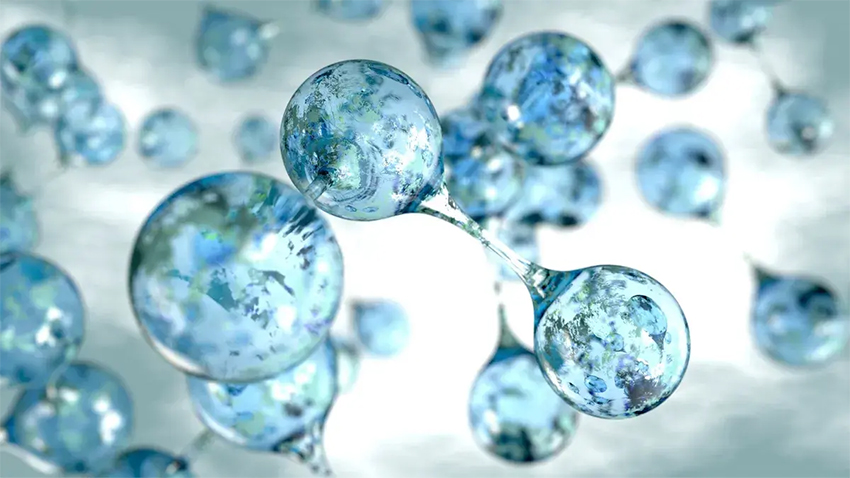|

September 7, 2023
By Sade Agard
Chemists discover new way to split
water for easier hydrogen

Concept image of water-splitting
process.
A team of German chemists based at Münster
University has unveiled a potentially groundbreaking water-splitting
method that promises to simplify the production of hydrogen.
Their research, recently published in the journal Nature,
introduces a photocatalytic method that leverages light energy to
activate water, potentially opening up new avenues in chemistry,
particularly in the synthesis of compounds from simpler materials.
Splitting water using light
Water splitting, a chemical reaction that disassembles water
into its elemental components of oxygen and hydrogen, has long
intrigued scientists due to its potential in various fields.
Photocatalysis, on the other hand, harnesses the power of light
to drive chemical reactions.
In this innovative method developed by the German
research team, triaryl phosphines, a type of organic phosphine with
numerous industrial applications, including as light and heat
stabilizers, play a significant role in simplifying hydrogen
production.
What sets this water-splitting approach apart is its remarkable
efficiency in generating hydrogen, a resource viewed as a promising
energy solution for the future.
Moreover, hydrogen plays an essential role in forming various
crucial compounds.
The challenge in splitting water lies in its inherent
stability, making the separation of hydrogen and oxygen atoms a
complex endeavor. A catalyst is typically required to activate water
for this process to occur.
Led by Professor Armido Studer from the university's Institute
of Organic Chemistry, the team devised a photocatalytic process to
activate water, diverging from the conventional use of transition
metal complexes commonly employed in such reactions.
In their novel approach, the researchers used triaryl
phosphines instead. Under gentle reaction conditions, light emitted by
an LED facilitates the transfer of a hydrogen atom to a phosphine-water
radical cation.
Radicals are known for their high reactivity, and the phosphine-water
radical cation excels as an intermediate for activating water.
Consequently, hydrogen atoms can be readily separated and transferred
to a substrate.
In a Debrief article, Professor Studer explained that their
system "offers an ideal platform for investigating unresearched
chemical processes that use the hydrogen atom as a reagent in
synthesis."
The implications of this breakthrough in water splitting are
vast and extend to multiple scientific domains. For instance, this
development may yield transformative applications in the realm of
material sciences, agriculture, and pharmaceutical research.
As the scientific community further explores this innovative
water-splitting technique, it will be intriguing to observe how
various fields of study utilize its simplicity and efficiency for
advancement.
The complete study was published in Nature and can be found
here.
Study abstract:
Transition metal (oxy)hydroxides are promising electrocatalysts
for the oxygen evolution reaction1,2,3. The properties of these
materials evolve dynamically and heterogeneously4 with applied voltage
through ion insertion redox reactions, converting materials that are
inactive under open circuit conditions into active electrocatalysts
during operation5. The catalytic state is thus inherently far from
equilibrium, which complicates its direct observation. Here, using a
suite of correlative operando scanning probe and X-ray microscopy
techniques, we establish a link between the oxygen evolution activity
and the local operational chemical, physical and electronic nanoscale
structure of single-crystalline β-Co(OH)2 platelet particles. At
pre-catalytic voltages, the particles swell to form an
α-CoO2H1.5·0.5H2O-like structure—produced through hydroxide
intercalation—in which the oxidation state of cobalt is +2.5. Upon
increasing the voltage to drive oxygen evolution, interlayer water and
protons de-intercalate to form contracted β-CoOOH particles that
contain Co3+ species. Although these transformations manifest
heterogeneously through the bulk of the particles, the electrochemical
current is primarily restricted to their edge facets. The observed
Tafel behaviour is correlated with the local concentration of Co3+ at
these reactive edge sites, demonstrating the link between bulk
ion-insertion and surface catalytic activity.
Green Play Ammonia™, Yielder® NFuel Energy.
Spokane, Washington. 99212
509 995 1879
Cell, Pacific Time Zone.
General office:
509-254
6854
4501 East Trent
Ave.
Spokane, WA 99212
|